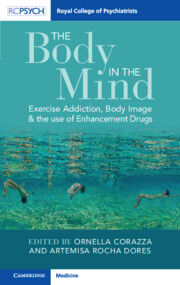Book contents
- The Body in the Mind
- The Body in the Mind
- Copyright page
- Dedication
- Contents
- Figures
- Tables
- Boxes
- Contributors
- Acknowledgements
- Introduction
- Section 1 From Exercise to Addiction: An Introduction to the Phenomenon
- Chapter 1 Exercise Addiction
- Chapter 2 From Exercise to Addiction
- Chapter 3 The COVID-19 Pandemic
- Chapter 4 Excessive Exercise and Image- and Performance-Enhancing Drug Use Among Sports Disciplines, and the Role of Mind–Body Training
- Chapter 5 The Ideal of the Perfect Body
- Chapter 6 Exercise, Fitspiration, and the Role of Social Media
- Chapter 7 Eating Disorders and Over-Exercise
- Chapter 8 Exercise and the Use of Image- and Performance-Enhancing Drugs within the Gym Environment
- Chapter 9 Bodybuilding, Exercise, and Image- and Performance-Enhancing Drug Use during the COVID-19 Pandemic
- Chapter 10 How to Treat Exercise Addiction
- Section 2 Reaching the Extreme with Exercise: A Collection of Clinical Case Studies
- Section 3 Exploring the Motivations Behind Exercise Addiction
- Index
- References
Chapter 3 - The COVID-19 Pandemic
A Novel Risk Factor for Exercise Addiction and Related Disorders
from Section 1 - From Exercise to Addiction: An Introduction to the Phenomenon
Published online by Cambridge University Press: 30 March 2023
- The Body in the Mind
- The Body in the Mind
- Copyright page
- Dedication
- Contents
- Figures
- Tables
- Boxes
- Contributors
- Acknowledgements
- Introduction
- Section 1 From Exercise to Addiction: An Introduction to the Phenomenon
- Chapter 1 Exercise Addiction
- Chapter 2 From Exercise to Addiction
- Chapter 3 The COVID-19 Pandemic
- Chapter 4 Excessive Exercise and Image- and Performance-Enhancing Drug Use Among Sports Disciplines, and the Role of Mind–Body Training
- Chapter 5 The Ideal of the Perfect Body
- Chapter 6 Exercise, Fitspiration, and the Role of Social Media
- Chapter 7 Eating Disorders and Over-Exercise
- Chapter 8 Exercise and the Use of Image- and Performance-Enhancing Drugs within the Gym Environment
- Chapter 9 Bodybuilding, Exercise, and Image- and Performance-Enhancing Drug Use during the COVID-19 Pandemic
- Chapter 10 How to Treat Exercise Addiction
- Section 2 Reaching the Extreme with Exercise: A Collection of Clinical Case Studies
- Section 3 Exploring the Motivations Behind Exercise Addiction
- Index
- References
Summary
Exercise addiction (AE), which can be defined as engaging in excessive and problematic physical exercise, is still not officially included in the psychiatric nosography, although this disorder can be identified as linked to addictive behaviours. Many different etiopathogenetic hypotheses have been proposed to account for the epidemiological distribution of EA in the general population. However, a clear phenomenological concept of the disorder and shared diagnostic tools are still lacking. It is frequently comorbid with eating disorders and body dysmorphic disorder, which can both trigger EA and develop secondary to it. In recent times it has been proposed that the lockdowns and other restrictions which were imposed during the COVID-19 pandemic could have been possible risk factors for the development or worsening of EA, as physical exercise was widely recommended as a strategy for coping with these restrictions. The initial evidence about the emergence of EA during the COVID-19 pandemic is presented.
Keywords
- Type
- Chapter
- Information
- The Body in the MindExercise Addiction, Body Image and the Use of Enhancement Drugs, pp. 49 - 66Publisher: Cambridge University PressPrint publication year: 2023

